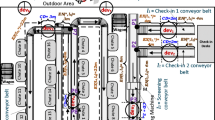Abstract
The increasing deployment of indoor positioning technologies like RFID, Wi-fi, and Bluetooth offers the possibility to obtain users’ trajectories in indoor spaces. In this paper, based on indoor moving-object trajectories, we aim to detect hotspots from indoor trajectory data. Such information is helpful for users to understand the surrounding locations as well as to enable indoor trajectory mining and location recommendation. We first define a new kind of query called indoor hotspot query. Then, we introduce a pre-processing step to remove meaningless locations and obtain indoor stay trajectories. Further, we propose a new approach to answering indoor hotspot queries w.r.t. two factors: (1) users’ interests in indoor locations, and (2) the mutual reinforcement relationship between users and indoor locations. Particularly, we construct a user-location matrix and use an iteration-based technique to compute the hotness of indoor locations. We evaluate our proposal on 223,564 indoor tracking records simulating 100 users’ movements over a period of one month in a six-floor building. The results in terms of MAP, P@n, and nDCG show that our proposal outperforms baseline methods like rank-by-visit, rank-by-density, and rank-by-duration.
Access this chapter
Tax calculation will be finalised at checkout
Purchases are for personal use only
Preview
Unable to display preview. Download preview PDF.
Similar content being viewed by others
References
Jensen, C.S., Lu, H., Yang, B.: Indoor - A New Data Management Frontier. IEEE Data Engineering Bulletin 33(2), 12–17 (2010)
Li, Q., Jin, P., Zhao, L., Wan, S., Yue, L.: IndoorDB: extending oracle to support indoor moving objects management. In: Meng, W., Feng, L., Bressan, S., Winiwarter, W., Song, W. (eds.) DASFAA 2013, Part II. LNCS, vol. 7826, pp. 476–480. Springer, Heidelberg (2013)
Hadjieleftheriou, M., Kollios, G., Gunopulos, D., Tsotras, V.J.: On-line discovery of dense areas in spatio-temporal databases. In: Hadzilacos, T., Manolopoulos, Y., Roddick, J., Theodoridis, Y. (eds.) SSTD 2003. LNCS, vol. 2750, pp. 306–324. Springer, Heidelberg (2003)
Jensen, C.S., Lin, D., Ooi, B.C., Zhang, R.: Effective density queries on continuously moving objects. In: Proc. of ICDE, p. 71 (2006)
Li, X., Han, J., Lee, J.-G., Gonzalez, H.: Traffic density-based discovery of hot routes in road networks. In: Papadias, D., Zhang, D., Kollios, G. (eds.) SSTD 2007. LNCS, vol. 4605, pp. 441–459. Springer, Heidelberg (2007)
Giannotti, F., Nanni, M., Pinelli, F., Pedreschi, D.: Trajectory pattern mining. In: Proc. of KDD, pp. 330–339 (2007)
Alvares, L.O., Bogorny, V., Kuijpers, B., et al.: A model for enriching trajectories with semantic geographical information. In: Proc. of GIS, p. 22 (2007)
Ahmed, T., Pedersen, T.B., Lu, H.: Capturing hotspots for constrained indoor movement. In: Proc. of GIS, pp. 462–465 (2013)
Palma, A.T., Bogorny, V., Kuijpers, B., Alvares, L.O.: A clustering-based approach for discovering interesting places in trajectories. In: Proc. of SAC, pp. 863–868 (2008)
Uddin, M.R., Ravishankar, C.V., Tsotras, V.J.: Finding regions of interest from trajectory data. In: Proc. of MDM, pp. 39–48 (2011)
Dudas, P., Ghafourian, M., Karimi, H.: ONALIN: Ontology and algorithm for indoor routing. In: Proc. of MDM, pp. 720–725 (2009)
Kim, J., Kang, H., Lee, T., et al.: Topology of the prism model for 3D indoor spatial objects. In: Proc. of MDM, pp. 698–703 (2009)
Wang, N., Jin, P., Xiong, Y., Yue, L.: A multi-granularity grid-based graph model for indoor space. International Journal of Multimedia and Ubiquitous Engineering 9(4), 157–170 (2014)
Jensen, C.S., Lu, H., Yang, B.: Graph model based indoor tracking. mobile data management. In: Proc. of MDM, pp. 17–24 (2008)
Jin, P., Zhang, L., Zhao, J., Zhao, L., Yue, L.: Semantics and modeling of indoor moving objects. International Journal of Multimedia and Ubiquitous Engineering 7(2), 153–158 (2012)
Huang, C., Jin, P., Wang, H., Wang, N., Wan, S., Yue, L.: IndoorSTG: a flexible tool to generate trajectory data for indoor moving objects. In: Proc. of MDM, pp. 341–343 (2013)
Manning, C.D., Raghavanm, P., Schütze, H.: An Introduction to Information Retrieval. Cambridge University Press (2008)
Zheng, Y., Zhang, L., Xie, X., Ma, W.-Y.: Mining interesting locations and travel sequences from GPS trajectories. In: Proc. of WWW, pp. 791–800 (2009)
Cao, X., Cong, G., Jensen, C.S.: Mining significant semantic locations from GPS data. PVLDB 3(1), 1009–1020 (2010)
Ahmed, T., Pedersen, T.B., Lu, H.: Finding dense locations in indoor tracking data. In: Proc. of MDM, pp. 189–194 (2014)
Schafer, M., Knapp, C., Chakraborty, S.: Automatic generation of topological indoor maps for real-time map-based localization and tracking. In: Proc. of IPIN, pp. 1–8. IEEE CS (2011)
Author information
Authors and Affiliations
Corresponding author
Editor information
Editors and Affiliations
Rights and permissions
Copyright information
© 2015 Springer International Publishing Switzerland
About this paper
Cite this paper
Jin, P., Du, J., Huang, C., Wan, S., Yue, L. (2015). Detecting Hotspots from Trajectory Data in Indoor Spaces. In: Renz, M., Shahabi, C., Zhou, X., Cheema, M. (eds) Database Systems for Advanced Applications. DASFAA 2015. Lecture Notes in Computer Science(), vol 9049. Springer, Cham. https://doi.org/10.1007/978-3-319-18120-2_13
Download citation
DOI: https://doi.org/10.1007/978-3-319-18120-2_13
Published:
Publisher Name: Springer, Cham
Print ISBN: 978-3-319-18119-6
Online ISBN: 978-3-319-18120-2
eBook Packages: Computer ScienceComputer Science (R0)




